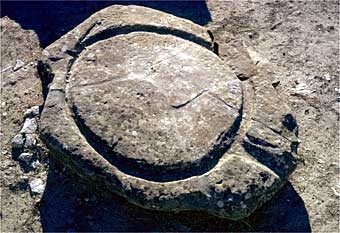- Home
- Artisans and farmers
- Agriculture
The preservation or transformation of agricultural products for immediate or later consumption required machines or equipment of varied complexity, many of which left no archaeological traces (foodstuffs preserved in sacs, for example). Three essential Mediterranean agricultural products, cereals, grapes, and olives, are attested at Entremont by numerous, clearly identifiable remains.
Room floor: silo surrounded by dolia bottoms.
Cereals
Grains could have been preserved in sacs, wood or unbaked clay huts, jars, or silos dug into the ground. At Entremont, only jars (or dolia, but these also served for oil and wine) and one large silo have been found.
The fabrication of flour, which is attested as early as the Neolithic period by rudimentary millstones, was perfected at the beginning of the Iron Age by the development in the Greek world of the slotted millstone. The mobile stone of this machine, which moves back and forth over the immobile stone, has the shape of a rounded basin, which serves as a reservoir. It is pierced with slot, which facilitates the crushing of grains between the two stones. The process was then further improved by the Iberians who invented the rotating millstone, which was equipped with a metallic axe and a crank fixed with lead. Both types of millstones existed at Entremont (made from basalt), but the slotted type was more rare. The agglomeration indeed seems to have developed at the moment that the slotted millstone was abandoned in favor of the rotating type. This phenomenon is attested somewhat earlier in the Languedoc region during the 4th century BC.
Oil press squeezer base.
Oil and wine
The fabrication of oil and wine could have been realized by techniques that leave no archaeological traces (pressing in a wooden vat for wine, twisting in resistant cloths for oil). Meanwhile, in Greece and Italy, the desire for greater productivity led very early on to the conception of machines employing characteristic stone blocks that can be identified by archaeologists. Several tens of these blocks have been found at Entremont. While many of them were broken and reused for the construction walls or as gravel, a few have been found in their original location of use.

